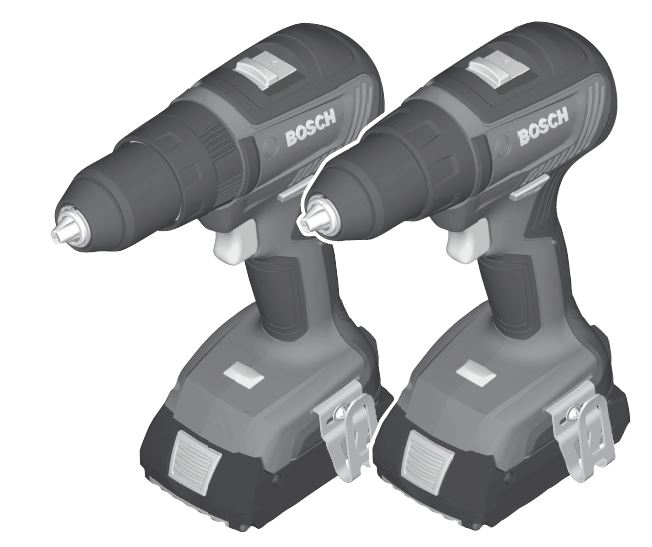User Manual

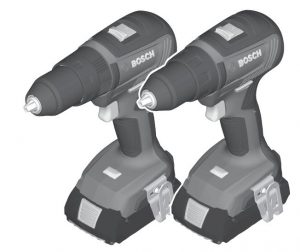
BOSCH GSB Professional Drill (18V-55)
Overview

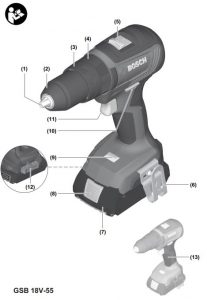
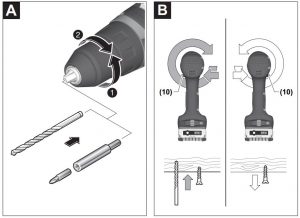
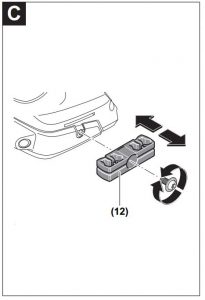
Safety Instructions
General Power Tool Safety Warnings
![]() WARNING
WARNING
Read all safety warnings, instructions, illustrations and specifications provided with this power tool. Failure to follow all instructions listed below may result in electric shock, fire and/ or serious injury.
Save all warnings and instructions for future reference.The term “power tool” in the warnings refers to your main soperated (corded) power tool or battery-operated (cordless) power tool.
Work area safety
- Keep work area clean and well lit. Cluttered or dark areas invite accidents.
- Do not operate power tools in explosive atmospheres, such as in the presence of flammable liquids, gases or dust. Power tools create sparks which may ignite the dust or fumes.
- Keep children and bystanders away while operating a power tool. Distractions can cause you to lose control.
Electrical safety
- Power tool plugs must match the outlet. Never modify the plug in any way. Do not use any adapter plugs with earthed (grounded) power tools. Unmodified plugs and matching outlets will reduce risk of electric shock.
- Avoid body contact with earthed or grounded surfaces, such as pipes, radiators, ranges and refrigerators. There is an increased risk of electric shock if your body is earthed or grounded.
- Do not expose power tools to rain or wet conditions. Water entering a power tool will increase the risk of electric shock.
- Do not abuse the cord. Never use the cord for carrying, pulling or unplugging the power tool. Keep cord away from heat, oil, sharp edges or moving parts. Damaged or entangled cords increase the risk of electric shock.
- When operating a power tool outdoors, use an extension cord suitable for outdoor use. Use of a cord suitable for outdoor use reduces the risk of electric shock.
- If operating a power tool in a damp location is unavoidable, use a residual current device (RCD) protected supply. Use of an RCD reduces the risk of electric shock.
Personal safety
- Stay alert, watch what you are doing and use common sense when operating a power tool. Do not use a power tool while you are tired or under the influence of drugs, alcohol or medication. A moment of inattention while operating power tools may result in serious personal injury.
- Use personal protective equipment. Always wear eye protection. Protective equipment such as a dust mask, non-skid safety shoes, hard hat or hearing protection used for appropriate conditions will reduce personal injuries.
- Prevent unintentional starting. Ensure the switch is in the off-position before connecting to power source and/or battery pack, picking up or carrying the tool. Carrying power tools with your finger on the switch or energising power tools that have the switch on invites accidents.
- Remove any adjusting key or wrench before turning the power tool on. A wrench or a key left attached to a rotating part of the power tool may result in personal injury.
- Do not overreach. Keep proper footing and balance at all times. This enables better control of the power tool in unexpected situations.
- Dress properly. Do not wear loose clothing or jewellery. Keep your hair and clothing away from moving parts. Loose clothes, jewellery or long hair can be caught in moving parts.
- If devices are provided for the connection of dust extraction and collection facilities, ensure these are connected and properly used. Use of dust collection can reduce dust-related hazards.
- Do not let familiarity gained from frequent use of tools allow you to become complacent and ignore tool safety principles. A careless action can cause severe injury within a fraction of a second.
Power tool use and care
- Do not force the power tool. Use the correct power tool for your application. The correct power tool will do the job better and safer at the rate for which it was designed.
- Do not use the power tool if the switch does not turn it on and off. Any power tool that cannot be controlled with the switch is dangerous and must be repaired.
- Disconnect the plug from the power source and/or remove the battery pack, if detachable, from the power tool before making any adjustments, changing accessories, or storing power tools. Such preventive safety measures reduce the risk of starting the power tool accidentally.
- Store idle power tools out of the reach of children and do not allow persons unfamiliar with the power tool or these instructions to operate the power tool. Power tools are dangerous in the hands of untrained users.
- Maintain power tools and accessories. Check for misalignment or binding of moving parts, breakage of parts and any other condition that may affect the power tool’s operation. If damaged, have the power tool repaired before use. Many accidents are caused by poorly maintained power tools.
- Keep cutting tools sharp and clean. Properly maintained cutting tools with sharp cutting edges are less likely to bind and are easier to control.
- Use the power tool, accessories and tool bits etc. in accordance with these instructions, taking into account the working conditions and the work to be performed. Use of the power tool for operations different from those intended could result in a hazardous situation.
- Keep handles and grasping surfaces dry, clean and free from oil and grease. Slippery handles and grasping surfaces do not allow for safe handling and control of the tool in unexpected situations.
Battery tool use and care
- Recharge only with the charger specified by the manufacturer. A charger that is suitable for one type of battery pack may create a risk of fire when used with another battery pack.
- Use power tools only with specifically designated battery packs. Use of any other battery packs may create a risk of injury and fire.
- When battery pack is not in use, keep it away from other metal objects, like paper clips, coins, keys, nails, screws or other small metal objects, that can make a connection from one terminal to another. Shorting the battery terminals together may cause burns or a fire.
- Under abusive conditions, liquid may be ejected from the battery; avoid contact. If contact accidentally occurs, flush with water. If liquid contacts eyes, additionally seek medical help. Liquid ejected from the battery may cause irritation or burns.
- Do not use a battery pack or tool that is damaged or modified. Damaged or modified batteries may exhibit unpredictable behaviour resulting in fire, explosion or risk of injury.
- Do not expose a battery pack or tool to fire or excessive temperature. Exposure to fire or temperature above 130°C may cause explosion.
- Follow all charging instructions and do not charge the battery pack or tool outside the temperature range specified in the instructions. Charging improperly or at temperatures outside the specified range may damage the battery and increase the risk of fire.
Service
- Have your power tool serviced by a qualified repair person using only identical replacement parts. This will ensure that the safety of the power tool is maintained.
- Never service damaged battery packs. Service of battery packs should only be performed by the manufacturer or authorized service providers.
Safety information for drills and screwdriversSafety instructions for all operations
- Wear ear protectors when impact drilling. Exposure to noise can cause hearing loss.
- Hold the power tool by insulated gripping surfaces, when performing an operation where the cutting accessory or fasteners may contact hidden wiring. Cutting accessory or fasteners contacting a “live” wire may make exposed metal parts of the power tool “live” and could give the operator an electric shock.
Safety instructions when using long drill bits
- Never operate at higher speed than the maximum speed rating of the drill bit. At higher speeds, the bit is likely to bend if allowed to rotate freely without contacting the work piece, resulting in personal injury.
- Always start drilling at low speed and with the bit tip in contact with the work piece. At higher speeds, the bit is likely to bend if allowed to rotate freely without contacting the work piece, resulting in personal injury.
- Apply pressure only in direct line with the bit and do not apply excessive pressure.Bits can bend causing breakage or loss of control, resulting in personal injury.
Additional safety warnings
- Hold the power tool securely. When tightening and loosening screws be prepared for temporarily high torque reactions.
- Secure the work piece. A workpiece clamped with clamping devices or in a vice is held more secure than by hand.
- Use suitable detectors to determine if there are hidden supply lines or contact the local utility company for assistance. Contact with electric cables can cause fire and electric shock. Damaging gas lines can lead to explosion. Breaking water pipes causes property damage.
- Always wait until the power tool has come to a complete stop before placing it down. The application tool can jam and cause you to lose control of the power tool.
- In case of damage and improper use of the battery, vapours may be emitted. The battery can set alight or explode. Ensure the area is well ventilated and seek medical attention should you experience any adverse effects. The vapours may irritate the respiratory system.
- Do not open the battery. There is a risk of short-circuiting.
- The battery can be damaged by pointed objects such as nails or screwdrivers or by force applied externally. An internal short circuit may occur, causing the battery to burn, smoke, explode or overheat.
- Only use the battery with products from the manufacturer. This is the only way in which you can protect the battery against dangerous overload.
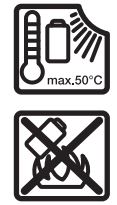
Protect the battery against heat, e.g. against continuous intense sunlight, fire, dirt, water and moisture. There is a risk of explosion and short-circuiting.
- Switch the power tool off immediately if the application tool becomes blocked. Be prepared for high torque reactions which cause kickback. The application tool becomes blocked when it becomes jammed in the workpiece or when the power tool becomes overloaded.
Product Description and Specifications
Read all the safety and general instructions. Failure to observe the safety and general instructions may result in electric shock, fire and/or serious injury.
Please observe the illustrations at the beginning of this operating manual.
Intended useThe power tool is intended for driving and loosening screws and for drilling in wood, metal, ceramic and plastic. The GSB is also designed for impact drilling in brick, masonry and stone.
Product FeaturesThe numbering of the product features refers to the diagram of the power tool on the graphics page.
- Tool holder
- Keyless chuck
- Torque presetting ring
- Operating mode presetting ring (GSB 18V-55)
- Gear selector switch
- Belt clip
- Battery
- Battery release button
- Worklight (LED)
- Rotational direction switch
- On/off switch
- Bit holder
- Handle (insulated gripping surface)
a) Accessories shown or described are not included with the product as standard. You can find the complete selection of accessories in our accessories range.
Technical data
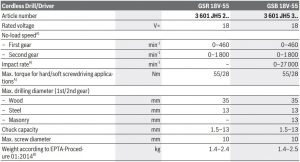

A) Measured at 20−25 °C with rechargeable battery GBA 18V 5.0Ah.B) Measured with GBA 18V 1.5Ah and GBA 18V 12 Ah.
Noise/Vibration Information


The vibration level and noise emission value given in these instructions have been measured in accordance with a standardised measuring procedure and may be used to compare power tools. They may also be used for a preliminary estimation of vibration and noise emissions.
The stated vibration level and noise emission value represent the main applications of the power tool. However, if the power tool is used for other applications, with different application tools or is poorly maintained, the vibration level and noise emission value may differ. This may significantly increase the vibration and noise emissions over the total working period.
To estimate vibration and noise emissions accurately, the times when the tool is switched off or when it is running but not actually being used should also be taken into account. This may significantly reduce vibration and noise emissions over the total working period.
Implement additional safety measures to protect the operator from the effects of vibration, such as servicing the power tool and application tools, keeping their hands warm, and organising workflows correctly.
Assembly
Remove the battery from the power tool before carrying out work on the power tool (e.g. maintenance, changing tool, etc.). The battery should also be removed for transport and storage. There is risk of injury from unintentionally pressing the on/off switch.
Charging the BatteryUse only the chargers listed in the technical data. Only these chargers are matched to the lithium-ion battery of your power tool.
Note: The battery is supplied partially charged. To ensure full battery capacity, fully charge the battery in the charger before using your power tool for the first time.
The lithium-ion battery can be charged at any time without reducing its service life. Interrupting the charging process does not damage the battery.
The lithium-ion battery is protected against deep discharge by the “Electronic Cell Protection (ECP)”. When the battery is discharged, the power tool is switched off by means of a protective circuit: The application tool no longer rotates. Follow the instructions on correct disposal.
Removing the Battery
The battery (7) is equipped with two locking levels to prevent the battery from falling out when pushing the battery release button (8) unintentionally. As long as the battery is inserted in the power tool, it is held in position by means of a spring.
To remove the battery (7), press the release button (8) and pull the battery out of the power tool. Do not use force to do this.
Battery charge indicator
The green LEDs on the battery charge indicator indicate the state of charge of the battery. For safety reasons, it is only possible to check the state of charge when the power tool is not in operation.
Press the button for the battery charge indicator ON or ![]() to show the state of charge. This is also possible when the battery is removed.
to show the state of charge. This is also possible when the battery is removed.
If no LED lights up after pressing the button for the battery charge indicator, then the battery is defective and must be replaced.
Battery model GBA 18V…
![]()
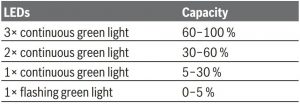
Battery model ProCORE18V…

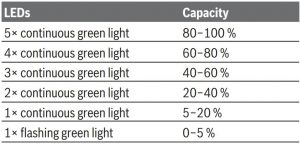
Changing the tool (see figure A)
- Remove the battery from the power tool before carrying out work on the power tool (e.g. maintenance, changing tool, etc.). The battery should also be removed for transport and storage. There is risk of injury from unintentionally pressing the on/off switch.
The drill spindle is locked when the on/off switch (11) is not pressed. This makes it possible to change the application tool in the drill chuck quickly, conveniently and easily. Open the keyless chuck (2) by turning it in the direction of rotation ➊ until the tool can be inserted. Insert the tool. Firmly tighten the keyless chuck (2) by turning it by hand in the direction of rotation ➋. This will automatically lock the drill chuck.
Dust/Chip ExtractionDust from materials such as lead-containing coatings, some wood types, minerals and metal can be harmful to one’s health. Touching or breathing-in the dust can cause allergic reactions and/or lead to respiratory infections of the user or bystanders.
Certain dust, such as oak or beech dust, is considered carcinogenic, especially in connection with wood-treatment additives (chromate, wood preservative). Materials containing asbestos may only be worked by specialists.
- Provide for good ventilation of the working place.
- It is recommended to wear a P2 filter-class respirator.
Observe the relevant regulations in your country for the materials to be worked.
Avoid dust accumulation at the workplace. Dust can easily ignite.
Operation
Starting OperationInserting the battery
Note: The use of batteries unsuitable for your power tool can lead to malfunctions or damage to the power tool. Push the charged battery (7) into the base of the power tool from the front until the battery is securely locked.
Setting the rotational direction (see figure B)The rotational direction switch (10) is used to change the rotational direction of the power tool. However, this is not possible while the on/off switch (11) is being pressed.
Right rotation: To drill and to drive in screws, press the rotational direction switch (10) through to the left stop.
Left Rotation: To loosen and unscrew screws and nuts, press the rotational direction switch (10) through to the right stop.
Setting the operating mode
![]() DrillingGSR 18V-55Set the torque presetting ring (3) to the “drilling” symbol.
DrillingGSR 18V-55Set the torque presetting ring (3) to the “drilling” symbol.
GSB 18V-55Set the operating mode presetting ring (4) to the “drilling” symbol.
 ScrewdrivingGSR 18V-55Set the torque presetting ring (3) to the required torque.
ScrewdrivingGSR 18V-55Set the torque presetting ring (3) to the required torque.
GSB 18V-55Set the operating mode presetting ring (4) to the “screwdriving” symbol. Set the torque presetting ring (3) to the required torque.
 Impact drillingGSB 18V-55Set the operating mode presetting ring (4) to the “impact drilling” symbol.
Impact drillingGSB 18V-55Set the operating mode presetting ring (4) to the “impact drilling” symbol.
Switching on/offTo start the power tool, press and hold the on/off switch (11).The LED (9) lights up when the on/off switch (11) is lightly or fully pressed, meaning that the work area is illuminated in poor lighting conditions.To switch off the power tool, release the on/off switch (11).
Adjusting the SpeedYou can adjust the speed of the power tool when it is on by pressing in the on/off switch (11) to varying extents.
A light pressure on the on/off switch (11) results in a low rotational speed. Increased pressure on the switch causes an increase in speed
Preselecting torque (applies to screwdriving mode)The torque presetting ring (3) can be used to pre-select the required torque in 20 stages. Once the set torque has been reached, the application tool will be stopped.
Mechanical gear selection
- Only operate the gear selector (5) when the power tool is not in use.
First gear:Low speed range; for working with a large drilling diameter or for screwdriving.
Second gear:High speed range; for working with a small drilling diameter.
Always push the gear selector switch as far as it will go. Otherwise, the power tool may become damaged.
Temperature-dependent overload protectionWhen used as intended, the power tool cannot be overloaded. In the event of overloading or the temperature rising/falling outside the permitted operating temperature range, the speed will be reduced. The power tool will not run at full speed again until the permitted operating temperature has been reached.
Fully automatic spindle lock (Auto-Lock)The drill spindle, and therefore the tool holder (1), are locked when the on/off switch (11) is not pressed.
This enables screws to be screwed in even when the battery (7) is empty and allows the power tool to be used as a screwdriver.
Practical advice
- Only apply the power tool to the screw when the tool is switched off. Rotating application tools can slip off.
Before screwing larger, longer screws into hard materials, it is advisable to pre-drill a pilot hole with the core diameter of the thread to approx. 2/3 of the screw length. An auxiliary tool can be used to remove the screwdriver bit or universal bit holder.
Belt clipYou can use the belt clip (6) to hang the power tool on a belt, for example. You then have both hands free and the power tool is always at hand.
Maintenance and Service
Maintenance and Cleaning
- Remove the battery from the power tool before carrying out work on the power tool (e.g. maintenance, changing tool, etc.). The battery should also be removed for transport and storage. There is risk of injury from unintentionally pressing the on/off switch.
- To ensure safe and efficient operation, always keep the power tool and the ventilation slots clean.
After-Sales Service and Application ServiceOur after-sales service responds to your questions concerning maintenance and repair of your product as well as spare parts. You can find explosion drawings and information on spare parts at: www.bosch-pt.com
The Bosch product use advice team will be happy to help you with any questions about our products and their accessories.
In all correspondence and spare parts orders, please always include the 10‑digit article number given on the nameplate of the product.
Great BritainRobert Bosch Ltd. (B.S.C.)P.O. Box 98Broadwater ParkNorth Orbital RoadDenham UxbridgeUB 9 5HJ
At www.bosch-pt.co.uk you can order spare parts or arrange the collection of a product in need of servicing or repair.Tel. Service: (0344) 7360109E-Mail: You can find further service addresses at: www.bosch-pt.com/serviceaddresses
TransportThe contained lithium-ion batteries are subject to the Dangerous Goods Legislation requirements. The batteries are suitable for road-transport by the user without further restrictions.
When shipping by third parties (e.g.: by air transport or forwarding agency), special requirements on packaging and labelling must be observed. For preparation of the item being shipped, consulting an expert for hazardous material is required.
Dispatch battery packs only when the housing is undamaged. Tape or mask off open contacts and pack up the battery in such a manner that it cannot move around in the packaging. Please also observe the possibility of more detailed national regulations.
Disposal
 Power tools, rechargeable batteries, accessories and packaging should be sorted for environmental- friendly recycling.
Power tools, rechargeable batteries, accessories and packaging should be sorted for environmental- friendly recycling.
![]() Do not dispose of power tools and batteries/rechargeable batteries into household waste!
Do not dispose of power tools and batteries/rechargeable batteries into household waste!
Only for EU countries:According to the Directive 2012/19/EU, power tools that are no longer usable, and according to the Directive 2006/66/EC, defective or used battery packs/batteries, must be collected separately and disposed of in an environmentally correct manner.
Battery packs/batteries:Li-ion:Please observe the notes in the section on transport (see “Transport”, page 18).
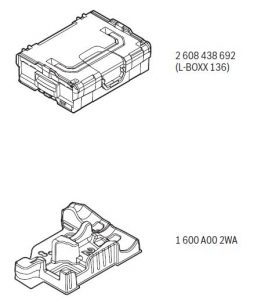
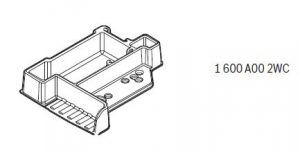
Licenses
Copyright © 2015, Infineon Technologies AGAll rights reserved.
Redistribution and use in source and binary forms, with or without modification, are permitted provided that the following conditions are met:
- Redistributions of source code must retain the above copyright notice, this list of conditions and the following disclaimer.
- Redistributions in binary form must reproduce the above copyright notice, this list of conditions and the following disclaimer in the documentation and/or other materials provided with the distribution.
- Neither the name of the copyright holders nor the names of its contributors may be used to endorse or promote products derived from this software without specific prior written permission.
THIS SOFTWARE IS PROVIDED BY THE COPYRIGHT HOLDERS AND CONTRIBUTORS “AS IS” AND ANY EXPRESS OR IMPLIED WARRANTIES, INCLUDING, BUT NOT LIMITED TO, THE IMPLIED WARRANTIES OF MERCHANTABILITY AND FITNESS FOR A PARTICULAR PURPOSE ARE DISCLAIMED. IN NO EVENT SHALL THE COPYRIGHT OWNER OR CONTRIBUTORS BE LIABLE FOR ANY DIRECT, INDIRECT, INCIDENTAL, SPECIAL, EXEMPLARY, OR CONSEQUENTIAL DAMAGES (INCLUDING, BUT NOT LIMITED TO, PROCUREMENT OF SUBSTITUTE GOODS OR SERVICES; LOSS OF USE, DATA, OR PROFITS; OR BUSINESS INTERRUPTION) HOWEVER CAUSED AND ON ANY THEORY OF LIABILITY, WHETHER IN CONTRACT, STRICT LIABILITY, OR TORT (INCLUDING NEGLIGENCE OR OTHERWISE) ARISING IN ANY WAY OUT OF THE USE OF THIS SOFTWARE, EVEN IF ADVISED OF THE POSSIBILITY OF SUCH DAMAGE.
Copyright © 2009–2016 ARM LIMITEDAll rights reserved.Redistribution and use in source and binary forms, with or without modification, are permitted provided that the following conditions are met:
- Redistributions of source code must retain the above copyright notice, this list of conditions and the following disclaimer.
- Redistributions in binary form must reproduce the above copyright notice, this list of conditions and the following disclaimerin the documentation and/or other materials provided with the distribution.
- Neither the name of ARM nor the names of its contributors may be used to endorse or promote products derived from this software without specific prior written permission.
THIS SOFTWARE IS PROVIDED BY THE COPYRIGHT HOLDERS AND CONTRIBUTORS “AS IS” AND ANY EXPRESS OR IMPLIED WARRANTIES, INCLUDING, BUT NOT LIMITED TO, THE IMPLIED WARRANTIES OF MERCHANTABILITY AND FITNESS FOR A PARTICULAR PURPOSE ARE DISCLAIMED. IN NO EVENT SHALL THE COPYRIGHT OWNER OR CONTRIBUTORS BE LIABLE FOR ANY DIRECT, INDIRECT, INCIDENTAL, SPECIAL, EXEMPLARY, OR CONSEQUENTIAL DAMAGES (INCLUDING, BUT NOT LIMITED TO, PROCUREMENT OF SUBSTITUTE GOODS OR SERVICES; LOSS OF USE, DATA, OR PROFITS; OR BUSINESS INTERRUPTION) HOWEVER CAUSED AND ON ANY THEORY OF LIABILITY, WHETHER IN CONTRACT, STRICT LIABILITY, OR TORT (INCLUDING NEGLIGENCE OR OTHERWISE) ARISING IN ANY WAY OUT OF THE USE OF THIS SOFTWARE, EVEN IF ADVISED OF THE POSSIBILITY OF SUCH DAMAGE.
![]() EU Declaration of Conformity
EU Declaration of Conformity
We declare under our sole responsibility that the stated products comply with all applicable provisions of the directives and regulations listed below and are in conformity with the following standards. Technical file at: *
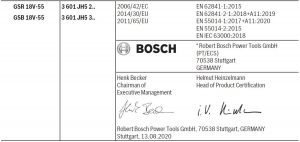
References
Scule electrice Bosch | Scule electrice Bosch
📧[email protected]
Invented for life | Bosch Global
Bosch elektromos kéziszerszámok | Bosch elektromos kéziszerszámok
📧[email protected]
Elektronarzędzia Bosch | Elektronarzędzia Bosch
ÐлекÑÑоинÑÑÑÑменÑÑ Bosch | Bosch Professional
Електроинструменти на Bosch | Електроинструменти на Bosch
📧[email protected]
Service worldwide
📧[email protected]
📧[email protected]
📧[email protected]
📧[email protected]
Elektrické nářadí Bosch | Elektrické nářadí Bosch
Bosch Elektrowerkzeuge und Zubehör | Bosch Elektrowerkzeuge
📧[email protected]
ÐлекÑÑоÑнÑÑÑÑменÑи Bosch | Bosch Professional
📧[email protected]
Loading…
📧[email protected]
Početna | Bosch u Hrvatskoj
📧[email protected]
📧[email protected]
Bosch električni alati | Bosch električni alati
Bosch-sähkötyökalut | Bosch-sähkötyökalut
Elektrické náradie Bosch | Elektrické náradie Bosch
📧[email protected]
Invented for life | Bosch Global
📧[email protected]
My Blog
📧[email protected]
📧[email protected]
📧[email protected]
📧[email protected]
[xyz-ips snippet=”download-snippet”]

